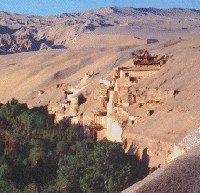| Art Q&A > Painting | กก |
|
Buddhist Art at Dunhuang
Since Dunhuang was the hub of cultural exchanges between China and the West along the Silk Road , the Dunhuang caves possess a special geographical and cultural significance. Dunhuang art is inevitably a result of a blend of multitudinous elements and styles, which retains China's cultural and art systems.
Legend has it that a monk named Yue Zun dug the first cave and also carved a Buddha statue into the sandstone cliff of Mingsha Mountain where the famous Mogao Grottoes are now located -- about 25 kilometers southeast of Dunhuang. Over 1,000 caves were carved out of cliffs between the fourth and 14th centuries. Dunhuang art began to decline in the 12th century and was ignored until the early years of the 20th century. Today, there are 492 caves remaining in the 1,600-meter-long cliff. The Mogao Grottoes are some of the best-preserved and most extensive collections of Buddhist paintings and sculptures in the world.
|
||||||
 |

 Brief History
Brief History
